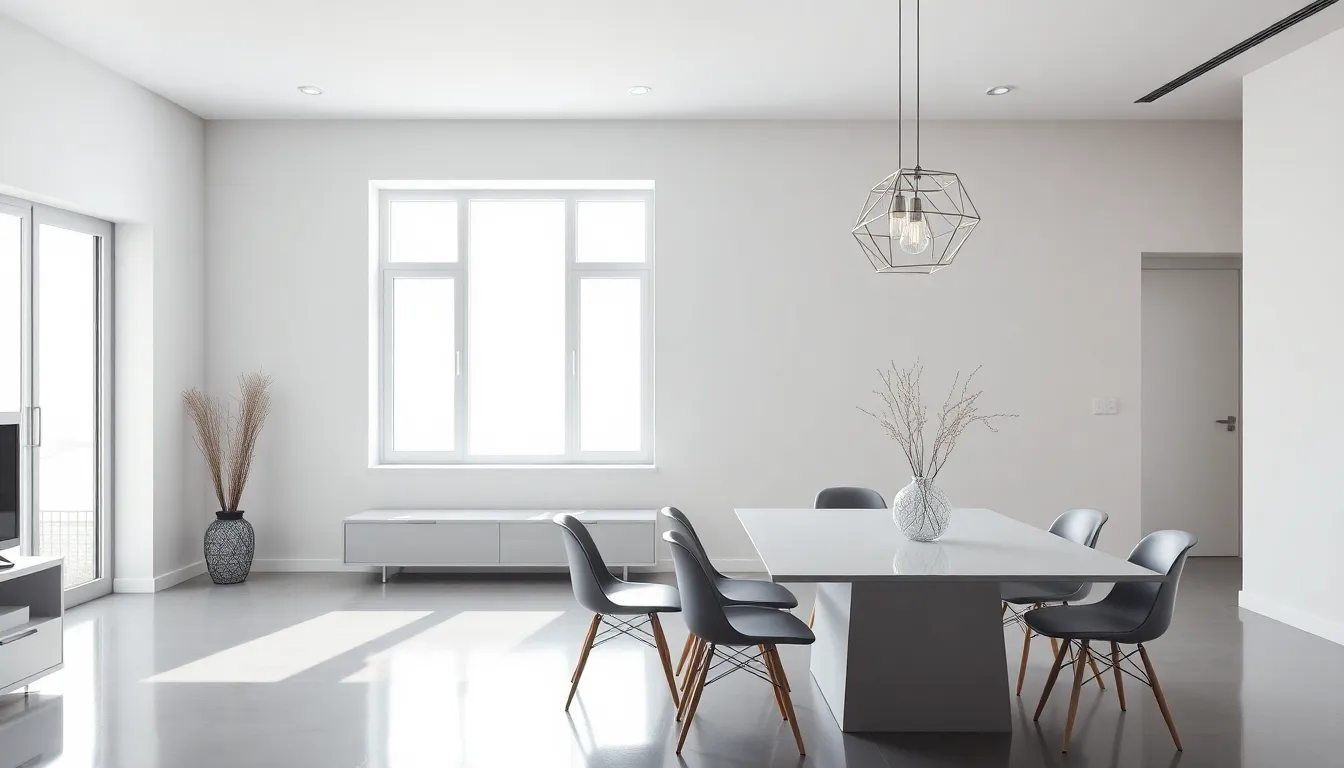Table of Contents
ToggleIn a world filled with visual noise, minimalist lighting design emerges as a breath of fresh air. This approach strips away the unnecessary, focusing on simplicity and functionality while creating a serene atmosphere. By emphasizing clean lines and understated elegance, minimalist lighting transforms spaces into tranquil havens that promote clarity and calm.
Minimalist lighting isn’t just about aesthetics; it’s also about enhancing the overall experience within a room. Thoughtful placement and design of light fixtures can highlight architectural features, create focal points, and evoke emotions. As more people seek balance in their lives, minimalist lighting design offers a perfect solution, blending beauty with purpose. Whether in homes, offices, or public spaces, this design philosophy paves the way for a more intentional and harmonious environment.
Overview Of Minimalist Lighting Design
Minimalist lighting design emphasizes simplicity and functionality. This approach focuses on creating serene environments by using subdued illumination and straightforward fixtures. Clean lines and understated elegance characterize minimalist lighting, contributing to a calm and tranquil atmosphere.
Thoughtful fixture placement plays a crucial role in enhancing a space. Each light source serves a specific purpose, ensuring effective illumination while maintaining harmony within the environment. For instance, strategically positioned wall sconces can provide ambient light without overwhelming the room’s aesthetics.
Minimalist lighting promotes balance and harmony in various settings, including residential, commercial, and public spaces. Each aspect blends seamlessly, allowing spaces to remain versatile and adaptable. Functionality remains paramount, confirming that every design element fulfills a practical need while contributing to the overall visual aesthetic.
Minimalist lighting design combines form and function to enrich environments through light, sustaining a peaceful and organized feel in any space.
Key Principles Of Minimalist Lighting

Minimalist lighting design revolves around two foundational principles: simplicity and functionality. These elements come together to create a peaceful ambiance, enhancing user experience in any environment.
Simplicity And Functionality
Simplicity defines minimalist lighting, characterized by clean lines and geometric shapes. Fixtures often highlight essential designs that blend harmoniously with their surroundings. Functionality prioritizes effective illumination needs, ensuring light sources serve distinct purposes without excess. For example, pendant lights offer targeted lighting in dining areas, while recessed lighting provides seamless brightness throughout a room. The combination of these aspects cultivates spaces that are both aesthetically pleasing and practical.
Use Of Natural Light
Natural light plays a pivotal role in minimalist lighting design. Designers emphasize maximizing daylight through architectural elements like large windows and skylights. Strategic placement of reflective surfaces further enhances brightness by bouncing light throughout the space. Maintaining a connection with the outdoors fosters tranquility, making areas feel more open and airy. By incorporating natural light, environments promote well-being while reducing reliance on artificial lighting.
Types Of Minimalist Lighting Fixtures
Minimalist lighting fixtures enhance the aesthetic of a space while providing necessary illumination. Each type serves specific functions, contributing to a cohesive design ethos.
Pendant Lights
Pendant lights feature a suspended design, ideal for focused illumination in dining areas and kitchen islands. Their sleek profiles and simple materials ensure a streamlined look. Various styles range from single bulb fixtures to clusters, creating visual interest without overwhelming a space. For instance, a minimalistic pendant with a matte finish complements modern decor, providing both light and a subtle design element. Designers often recommend using adjustable pendant heights to tailor illumination according to the setting and user needs.
Floor Lamps
Floor lamps provide versatile lighting solutions, offering ambient or task lighting in a variety of settings. Sleek designs promote effortless integration into minimalist themes. Many floor lamps incorporate adjustable features, allowing users to direct light where needed. Popular options include arc floor lamps, which feature a sweeping design suitable for living rooms, and tripod models, which often deliver a playful touch. When selecting floor lamps, opting for neutral colors and simple lines helps maintain the minimalist aesthetic while ensuring effective lighting.
Benefits Of Minimalist Lighting Design
Minimalist lighting design presents numerous advantages that enhance both aesthetics and functionality within spaces.
- Clarity and Focus: Minimalist lighting promotes clarity by eliminating visual clutter. It directs attention toward key features and elements, allowing for a more focused ambiance in any environment.
- Energy Efficiency: Minimalist designs often utilize LED fixtures and natural light sources, significantly reducing energy consumption. This eco-friendly approach aligns with modern sustainability goals while contributing to lower utility bills.
- Enhanced Space Perception: Minimalist lighting creates an illusion of spaciousness. By employing effective placement and reflective surfaces, it fosters a sense of openness and airiness, making rooms feel larger and more inviting.
- Versatile Aesthetics: Minimalist lighting easily adapts to various interior styles. It complements contemporary, industrial, and even traditional themes by offering timeless elegance without overpowering existing decor.
- Improved Mood: Thoughtful lighting enhances well-being. Natural light incorporation and soft, diffused LED options can elevate mood and support mental clarity, fostering a serene atmosphere conducive to relaxation or productivity.
- Cost-Effective Solutions: Minimalist designs often require fewer fixtures and less maintenance, leading to long-term cost savings. By focusing on essential lighting needs, environments remain both stylish and economically viable.
- Timeless Appeal: Minimalist lighting maintains its charm over time, ensuring that spaces remain modern and relevant. Its simplicity transcends trends, making it a lasting choice for long-term design.
These benefits showcase why minimalist lighting design appeals to both homeowners and designers, effectively marrying form with function to enhance living and working spaces.
Challenges In Minimalist Lighting Implementation
Implementing minimalist lighting design presents several challenges that can complicate the execution of the concept.
Limited Fixture Options
Limited options in lighting fixtures can restrict design flexibility. Many minimalist designs rely on specific types of fixtures that embody simplicity, making it difficult to find pieces that meet both aesthetic and functional requirements.
Inadequate Light Distribution
Inadequate light distribution can arise due to the minimalistic approach. Some spaces may require multiple light sources to achieve even illumination, while minimalist design tends to focus on fewer fixtures. This can lead to dark spots or uneven lighting, impacting overall ambiance.
Balancing Design and Functionality
Balancing design and functionality poses a significant challenge. While maintaining a clean aesthetic, each fixture must provide adequate illumination tailored to the room’s purpose. Misjudging this balance can lead to spaces that feel less inviting or efficient.
Integration with Existing Architecture
Integrating minimalist lighting with existing architecture often proves difficult. Traditional designs or architectural elements may clash with modern minimalist strategies, which can complicate retrofitting or enhancing older spaces.
Dependence on Natural Light
Dependence on natural light can impact the effectiveness of minimalist lighting. In locales with limited sunlight, the strategy of maximizing daylight with large windows or skylights may not always be viable, leaving designers to rely heavily on artificial sources.
Cost Considerations
Cost considerations can present hurdles when selecting high-quality minimalist fixtures. Premium materials and advanced technology often accompany minimalist designs, leading to higher initial investment requirements.
Maintenance Challenges
Maintenance challenges may arise as clean lines and integrated designs can obscure dust and dirt buildup. Maintaining the pristine appearance of minimalist fixtures demands regular attention, sometimes complicating the low-maintenance promise of minimalist aesthetics.
Navigating these challenges is essential for successfully implementing minimalist lighting and achieving the desired balance between aesthetic appeal and practical function.
Conclusion
Embracing minimalist lighting design offers a pathway to creating serene and functional spaces. By prioritizing simplicity and thoughtful placement, it enhances both aesthetics and well-being. The balance between form and function allows individuals to enjoy beautifully illuminated environments without the clutter of excess.
As designers continue to explore innovative solutions within this framework, the benefits of energy efficiency and visual clarity remain paramount. Minimalist lighting not only transforms spaces but also fosters a sense of tranquility and organization. With its timeless appeal, this approach is set to remain a staple in modern design practices, ensuring that every light source contributes meaningfully to the overall experience.







